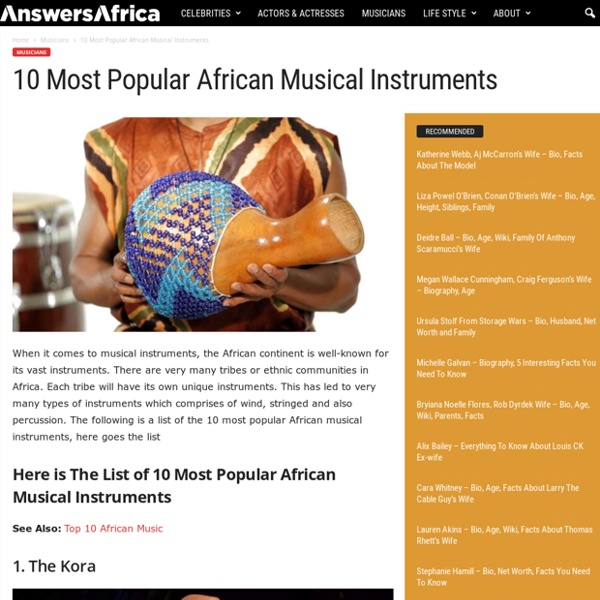Miriam Makeba
Miriam Makeba was born in Johannesburg in 1932, during a time of economic depression. Her mother, a domestic worker, was imprisoned for six months for illegally brewing beer to help make ends meet, and Miriam went to prison with her as she was just 18 days old. Makeba’s mother was also a sangoma, or a practitioner of herbal medicine, divination and counselling in traditional Zulu, Xhosa, Ndebele and Swazi (Nguni) societies of Southern Africa. After her father died, Miriam was sent to live with her grandmother at a compound in Riverside, Pretoria.
5 African musical icons you need to know - CBC Music
Written by Buhlebenkosi Chinhara From innovative maestros to powerhouse vocalists -- these are the most prominent and influential acts from the African continent. Hear: Miriam Makeba, Fela Kuti, Cesaria Evora, Ladysmith Black Mambazo, Amadou and Mariam and more!
African Music History - History Of Percussion Instruments
History Made Interesting Knowing about African music history helps you better understand the continent itself. Because music is so deeply rooted in African culture.
Why West Africa's pidgins deserve full recognition as official languages
The BBC World Service’s radio service of English-based Pidgin for West and Central Africa, BBC News Pidgin, is now a year old. And it’s thriving. According to the broadcaster it News Pidgin reaches a weekly audience of 7.5 million people in Nigeria and around the world on radio, online, Facebook and Instagram.
African music
History It is widely acknowledged that African music has undergone frequent and decisive changes throughout the centuries. What is termed traditional music today is probably very different from African music in former times.
World's largest refugee camp
Over the past month Kenya’s Dadaab refugee camp has marked several important events. More than 3,400 children from over 30 primary schools sat for Kenya’s national primary school examination. A new courthouse was also opened to help refugees resolve disputes. It’s hard to imagine that less than a year ago the camp was being threatened with closure by Kenya’s government.
Indigenous People of Africa
Swahili: Kenya, Tanzania, Mozambique, Uganda, Somalia, Comoros, Mayotte, Mauritius, Seychelles, Djibouti, Libya, South Africa, Zambia, Malawi, Madagascar, Eritrea, Ethiopia, Sudan, Rwanda, Burundi, Democratic Republic of Congo Return to Indigenous Peoples' Literature Compiled by: Glenn Welker ghwelker@gmx.com
Masai People
Welcome to Africa, AKA the motherland! Check out African Internet Radio while you're scoping the panoramas.The earliest fossil of the homo sapiens family (human beings) was found in Ethiopia, dating back more than 200,000 years. Compared to this length of time, even the "ancient Sumerians" from 6000 B.C. are drooling toddlers.Let's mention a few African heroes you may have heard of, for inspiration in the face of the continued economic inequality and violence which plague Africa today: Nelson Mandela, first democratically elected President of South Africa, who fought against apartheid and served 27 years in prison while advocating freedom and peace.



